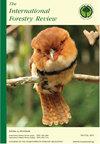快速通道土地改革方案及其对森林损失的影响:以津巴布韦马旺加布西森林保护区为例
IF 0.9
4区 农林科学
Q2 FORESTRY
引用次数: 0
摘要
快速土地改革方案(FTLRP)导致森林储备和生物多样性的丧失。为了可持续发展,需要与重新安置的农民共同管理森林保护区。遥感和地理信息系统在森林管理和监测中发挥着重要作用。森林管理方面法律文书和体制安排的多样性促进了森林的损失和滥用。必须对森林保护区的法律文书进行可持续管理和执行,以应对气候变化和荒漠化的影响。津巴布韦的土地改革,通常被称为快速通道土地改革计划(FTLRP),于2000年初建立。自FTRLP启动以来,森林和生物多样性的损失一直在上升。本文以马峰加布寺森林保护区为例,分析了ftlrp实施前、实施期间和实施后(1995-2019)的森林损失率。数据收集自半结构化问卷、访谈、卫星图像和实地调查。利用卫星影像进行监督分类,获得了土地覆盖、土地利用变化图和森林面积变化率回归图。结果表明:森林面积减少幅度为308 ha /年(2.4%),森林面积减少幅度为481 ha /年(5.2%)。森林资源重建方案的开始和用于支持社区参与森林管理的资金的撤出导致了随着人口的增长和对土地需求的增加而造成的森林损失。按照目前的森林损失速度,如果不采取措施降低森林损失速度,马峰堡寺森林很可能在未来20年内消失。因此,津巴布韦林业委员会、环境管理局和其他相关利益攸关方需要让重新安置的农民参与自然资源的可持续共同管理。这些努力将有助于应对气候变化的影响和保护生物多样性。本文章由计算机程序翻译,如有差异,请以英文原文为准。
The Fast Track Land Reform Programme and its Effect on the Loss of Forests: The Case of the Mafungabusi Forest Reserve in Zimbabwe
HIGHLIGHTS The Fast Track Land Reform Programme (FTLRP) resulted in the loss of forest reserves and biodiversity. Co-management of forest reserves with resettled farmers is required for sustainability. Remote sensing and GIS plays an important role in the management and monitoring of forests. Multiplicity of legal instruments and institutional arrangements in forest management promotes forest loss and misuse. Sustainable management and enforcement of legal instruments on forest reserves is required to combat effects of climate change and desertification. SUMMARY Land reform in Zimbabwe, commonly known as the Fast Track Land Reform Programme (FTLRP), was established in early 2000. Since the inception of the FTRLP, loss of forests and biodiversity has been on the rise. In this paper, an analysis of the rate of forest loss pre-FTLRP, during and post-FTLRP to date (1995–2019) is presented for the Mafungabusi Forest Reserve. Data were collected from semi-structured questionnaires, interviews, satellite imagery and fieldwork. Land Cover, Land-Use Change Maps were obtained from supervised classification of satellite imagery and regression graphs for the rate of change of forest area were also obtained. Results show that the forested areas decreased at a rate of 308 ha per year (2.4%) during the FTLRP and at a rate of 481 ha per year (5.2%) post FTLRP. The inception of FTLRP and the withdrawal of funds to support the Community Involvement in Forest Management (CIFM) resulted in forest loss as the population grew and demand for land increased. Given the current rate of forest loss, the Mafungabusi Forest will probably disappear in the next 20 years if no measures are taken to reduce the rate of forest loss. Thus, there is need for the Zimbabwe Forestry Commission, Environmental Management Agency and other relevant stakeholders to engage resettled farmers in sustainable co-management of natural resources. Such efforts will help in combating effects of climate change and conserving biodiversity.
求助全文
通过发布文献求助,成功后即可免费获取论文全文。
去求助
来源期刊

International Forestry Review
农林科学-林学
CiteScore
2.50
自引率
6.20%
发文量
29
审稿时长
>36 weeks
期刊介绍:
The International Forestry Review is a peer-reviewed scholarly journal that publishes original research and review papers on forest policy and science, with an emphasis on issues of transnational significance. It is published four times per year, in March, June, September and December. Special Issues are a regular feature and attract a wide audience. Click here for subscription details.
 求助内容:
求助内容: 应助结果提醒方式:
应助结果提醒方式:


